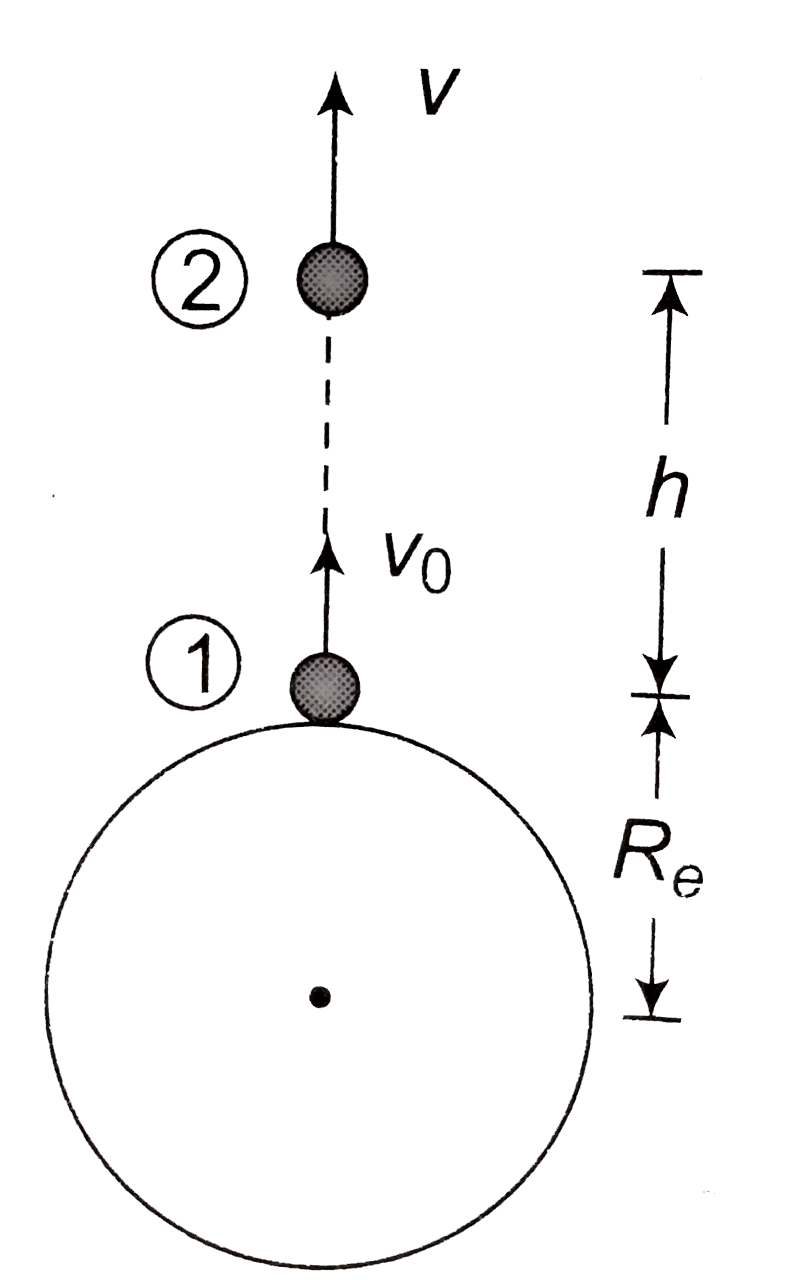A particle is fired vertically upward with a speed v0. Find
(a) Speed at distance 2Re from centre of earth.
(b) Calculated maximum height attained by particle.

Applying energy conservation between (1) and (2)
K1+U1=K2+U2
12mv20−GMemRe=12mv2−GMem(Re+h)
Re+h=2Re
12mv2=12mv20−GMemRe+GMem2Re
12mv20−GMem2Re
v2=v20−GMeRe
v=(v0−GMeRe)1/2=(v20−gR2e)1/2
(b) h=Hmax if v=0
12mv20=GMem[1Re−1Re+h]
v202GMe=hRe(Re+h)
h(Re+h)=v20Re2GMe=v20Re2gR2e=v202gRe
Re+hh=2gRev20
Reh+1=2gRev20
Reh=2gRev20−1
h=Re(2gRev20−1)=V20Re(2gRe−v20)
Topper's Solved these Questions
Similar Questions
A particle of mass m is fired vertically upward with speed v0(v0< escape speed ) . Prove that
(i) Maximum height attained by the particle is H=v20R2gR−v20 , where g is the acceleration due to gravity at the Earth's surface and R is the Earth's radius .
(ii) When the particel is at height h , the increase in gravitational potential energy is mgh1+hRView SolutionA particle is thrown vertically upward with speed 40m/s.
(a) After how much time attains maximum height?
(b) Find (i) the maximum height attained by the particle.
(ii) the velocity at half of the maximum height.
(c ) Find (i) the ratio of distances in the first half and the next half of time.
the ratio of the time in the first half and the second half of the distance (consider only upward journey)View Solution
Knowledge Check
- Question 1 - Select One or More
A particle is projected vertically upwards in vacuum with a speed u.
AWhen it rises to half its maximum height, its speed becomes u/2.BWhen it rises to half its maximum height, its speed becomes u/√2.CThe time taken to rise to half its maximum height is half the time taken to reach its maximum height.DThe time taken to rise to three− fourth of its maximum height is half the time taken to reach its maximum height. - Question 2 - Select One
A particle is prjected vertically upwards the surface of the earth (radius Re) with a speed equal to one fourth of escape velocity what is the maximum height attained by it from the surface of the earth?
A1615ReBRe15C415ReDNone of these - Question 3 - Select One
A particle is projected vertically upwards with a velocity √gR, where R denotes the radius of the earth and g the acceleration due to gravity on the surface of the earth. Then the maximum height ascended by the particle is
AReB2ReCRe2DNone of these
A particle is projected vertically upward the surface of the earth (radius Re ) with a speed equal to one-fourth of escape velocity. The maximum height attained by it from the surface of the earth is Rek. Find k.
View SolutionA ball is projected vertically upward with a speed of 50m/s. Find (a) the maximum height, (b) the time to reach the maximum height, (c) the speed at half the maximum height. Take g=10ms2.
View SolutionThere is crater of depth R/100 on the surface of the moon (raduis R). A projectile is fired vertically upwards from the crater with a velocity, which is equal to the escape velocity v from the surface of the moon. The maximum height attained by the projectile, is :
View SolutionIf an object is projected vertically upwards with speed , half the escape speed of earth , then the aximum height attained by it is [ R is radius of earth ]
View SolutionA particle is projected vertically upwards with speed v0. The drag force acting on it given by fdrag=mλv2. The time when it is at maximum height is :
View Solution

